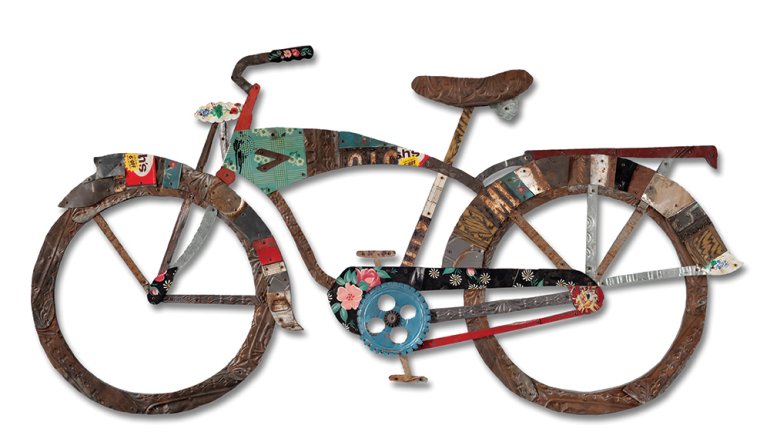Rescued & Reimagined
Rescued & Reimagined
Dolan Geiman’s mixed-media constructions begin in a number of unlikely places: a quiet field, an abandoned school building, a falling-down barn, a small-town scrap yard. From these wide-ranging sites, Geiman gathers all manner of materials – metal and wood, roof shingles, vintage papers, rusty old signs – and transforms them into contemporary yet nostalgic art, a sort of modernized Americana.
This balance between the new and the familiar reflects the artist’s trajectory. Raised in rural Virginia, Geiman now lives and works in Chicago, where his studio houses a vast collection of spoils from his far-flung treasure hunts. “It’s kind of like being an explorer,” he says. Often, an important part of the process is forming relationships – with farmers, landowners, and anyone else with unwanted materials. “Then you begin to get the story of the pieces themselves,” Geiman says, “and that’s really more fun.”
Geiman’s attraction to discarded objects, which he works with exclusively, and the thrill of discovering and repurposing them, date back to his rustic childhood. His mother, an artist, would take him for long, meandering walks, where they would gather abandoned ephemera – pieces of wire, decades-old tractor parts, rusty fence posts –and, back at home, turn their finds into art projects.
“As I got older, I realized there’s something in my blood where I have to go out and get dirty and wander in a field,” he says. That interaction with his surroundings, the larger context in which he finds and considers these materials – that’s the most exciting part. “There is a science to it, going through and determining that this is fit for a sculpture, or maybe this needs to sit outside for another five years,” he says. He keeps in touch with people at various “hot spots” around the country, dropping in every few years to sit, chat, have some pie, and inquire about that run-down barn on the property.
“The purpose for me is to recycle these materials into something new and give them new life,” he says. “I bring them back and put them in a place where people can look at them and enjoy it.”
That’s why it’s not quite as satisfying to source materials from, say, antique shops – it’s the rescue, the return from neglect and obscurity, that’s truly rewarding.
Sometimes this rescue process is less about relationships and more about extralegal boldness. “I’ve been given warnings, I’ve been shot at, I’ve been ushered out,” Geiman admits, recalling an expedition to an old farmhouse that was cut short by a cranky farmer taking aim with a bow and arrow. “But I’m going to keep doing it because I really want those materials.”
There are challenges to working exclusively with salvaged supplies. Paper reclaimed from 30-year-old schoolbooks is likely to fade, so Geiman has been experimenting with industrial varnishes to protect and preserve his found-paper collages. And ultimately, not everything is salvageable: Last year, Geiman got rid of several hundred pounds of metal ceiling tiles he’d been saving for years, after discovering they were made of toxic lead.
His collection of materials still includes objects from “the treasure trove of all treasure troves”: an uninhabited house, previously occupied by a hoarder, that he discovered while attending James Madison University in Harrisonburg, Virginia, more than a decade ago. Over a two-year period, art student Geiman made regular late-night trips to the house, armed with a flashlight and a Polaroid camera, to explore and catalogue the home’s inventory, which he can still describe in great detail: farm machinery, giant copper kettles, old jugs piled in the corner, moldy jars, bags of brand-new Strawberry Shortcake dolls and magnifying glasses, and on and on.
“Some people might say I’m a thief,” he says, “but I don’t see it that way; I’m taking something that no one is appreciating and reinventing it.”
Embedded in the final creations are the adventures Geiman embarks on to find, assess, and revive each component: the field he wandered, the farmer he befriended, the abandoned school he snuck into. Each piece embodies that most comforting and timeless aspect of the American dream: the potential for reinvention.
Danielle Maestretti is a frequent contributor to American Craft.

